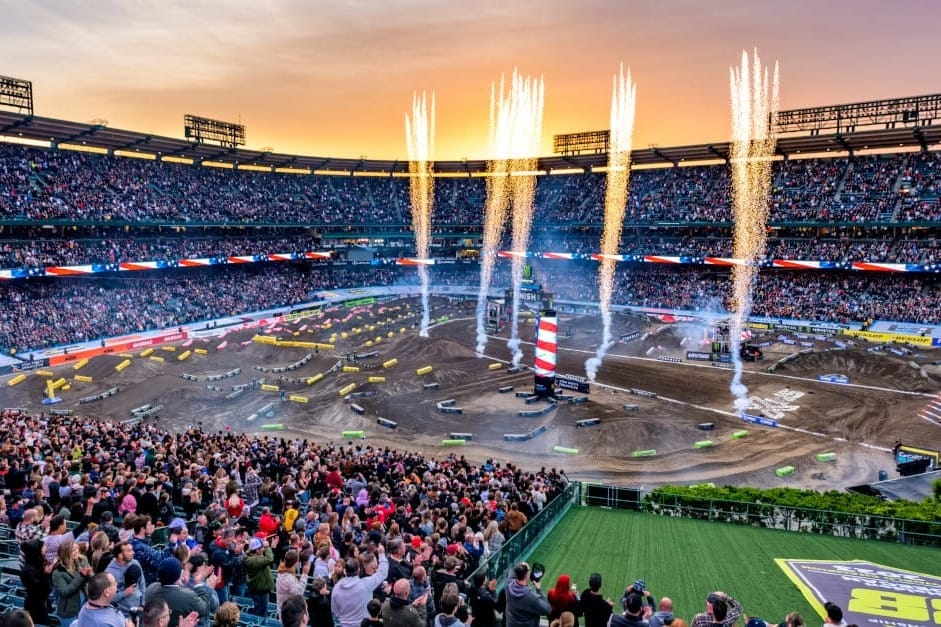While MotoGP’s focus last weekend might have been firmly on the unveiling of new team Trackhouse Racing’s stars-and-stripes-themed Aprilia machines on Friday night, it wasn’t the only two-wheeled event taking place in Los Angeles.
AMA Supercross was thrilling packed crowds at the Angels Stadium and those behind MotoGP were right to be present and keeping an ear open for some inspiration.
There’s no questioning that the domestic series is a huge success with American crowds. It drew in an average of 50,000 fans across each of its 17 rounds in 2023, and even more importantly has a fanbase demographic that skews young. With TV audiences increasing year-on-year and stadiums at capacity, it’s definitely a success story.
Those are all issues that MotoGP has been struggling with, and it’s perhaps no surprise that series promoter Dorna’s chief commercial officer Dan Rossomondo and sporting director Carlos Ezpeleta were in Anaheim on Saturday night for a look around - an experience that should have left the pair with plenty of ideas to take back to Barcelona.
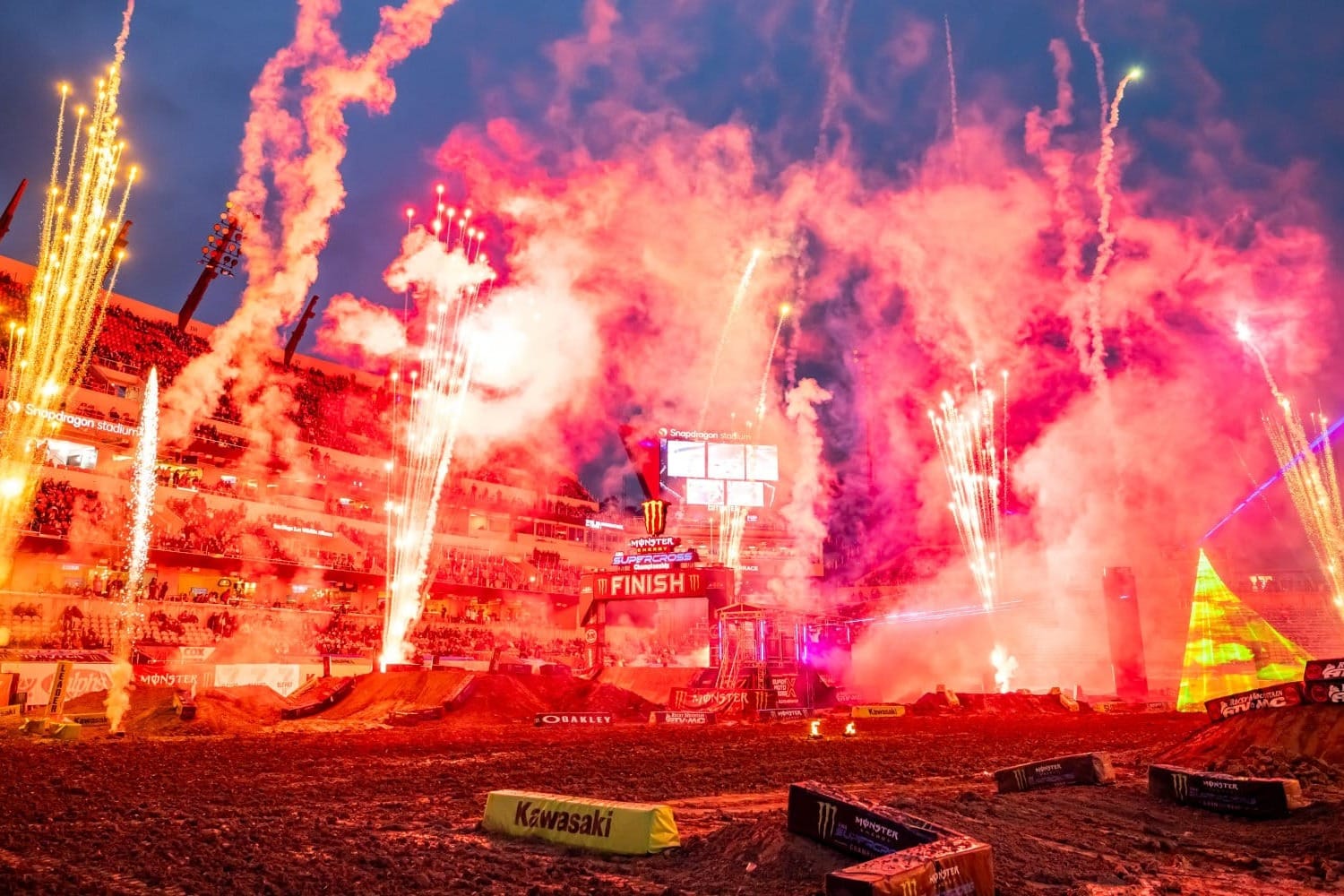
The first thing you notice about a night out at AMA Supercross is the show that comes alongside the on-track racing. Promoted by American company Feld Entertainment, it understands showmanship with its other big commercial operations including Disney on Ice and the famous Ringling Brothers circus.
There are huge fireworks displays and flamethrowers blasting the sky all night long. Singalong rock hits blare out at every break in the schedule. And there’s barely a break in the track action all night as AMA churns out heats and races to keep people engaged.
All in all, it’s a punchy show and, even if you’re not necessarily a motocross fan, there’s more than enough to engage.
The irony is, that comes despite the on-track product arguably not being as entertaining as MotoGP’s three-class offering.
Yes, races tend to open with bar-bashing mayhem into Turn 1, but to a casual fan they often very quickly stretch out. There’s a reason why this year the championship has introduced green lights on every bike that illuminate the race leader so that you can find them on track.
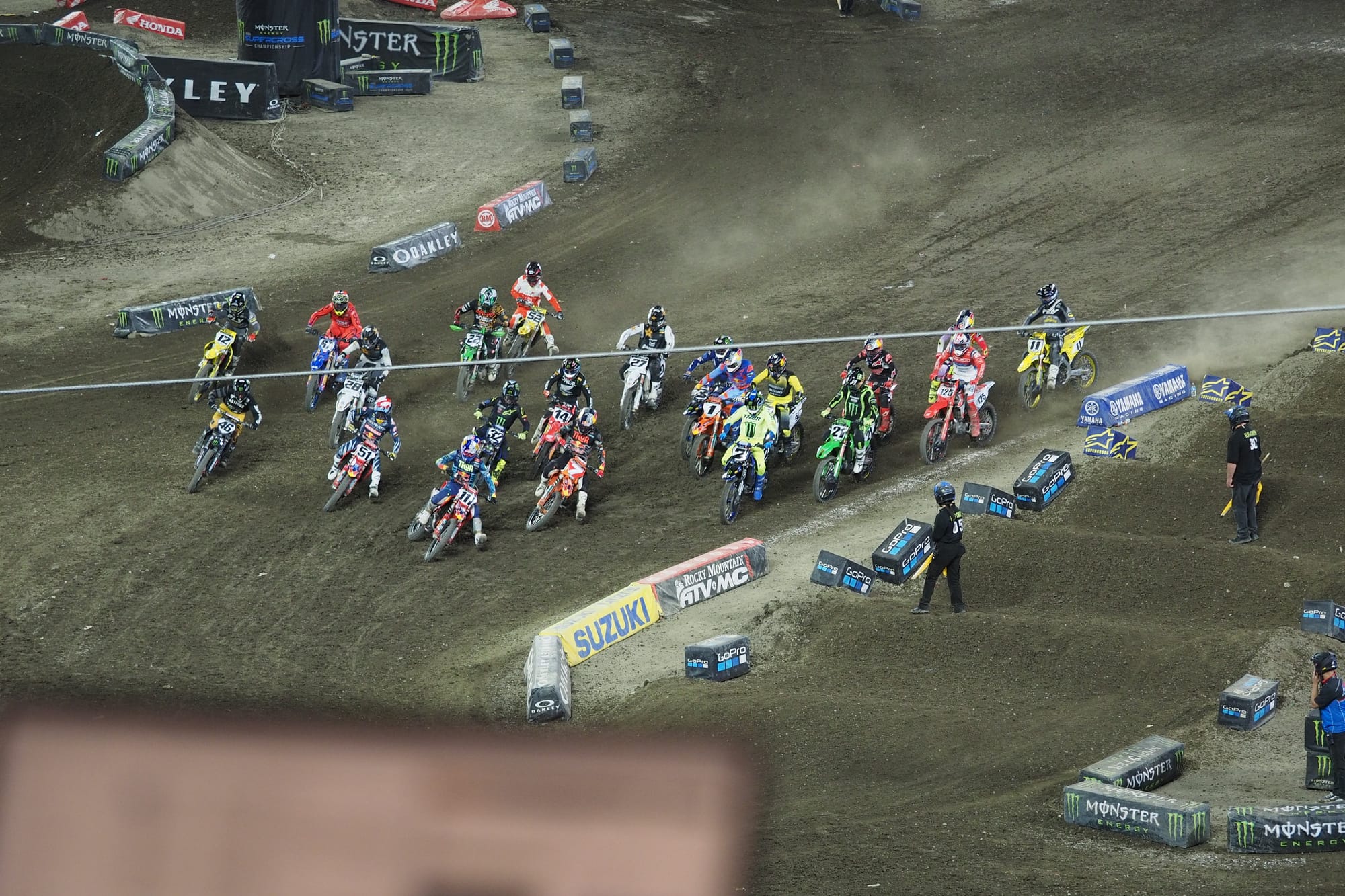
But it’s a testament to the whole event AMA puts on that audiences are still growing at a dramatic rate - and proof of what MotoGP should be looking at in its visit to the Anaheim race.
That show is easier to achieve when you’ve got a captive audience, and it also benefits hugely from the stadium setting. Replicating that element, at least, over a three-mile grand prix circuit is less easy - and not what MotoGP should be aiming for. It’s a very American experience, after all; one that works for a domestic championship but that might not translate the same way elsewhere.
Vince Friese grabs the @Ghostbusters Frozen Empire Holeshot in 450 Race 3 👻
— Supercross LIVE! (@SupercrossLIVE) January 28, 2024
🎥 Monster Energy 450 Race 3 LIVE fueled by @RalphsGrocery
See #Ghostbusters: Frozen Empire exclusively in theaters March 22nd 🎥#ScaryGoodSpeed #SupercrossLIVE #SMX pic.twitter.com/NgvRWYqiDk
But within how both series conduct themselves, there’s one key takeaway that MotoGP should realise: Supercross, simply put, doesn’t take itself too seriously. It understands what its audience is and what it likes, and the show AMA puts on is therefore tailored to suit, rather than trying to be something it’s not.
There’s definitely a sense of light-heartedness to the proceedings that you don’t get everywhere. It’s a little bit redneck and proud of it - and it works.
That’s in pretty stark contrast to what MotoGP has been doing far too much lately. You get the impression that under Dorna, MotoGP has tried to elevate itself to the level of F1 to the detriment of the traditional fanbase. The result has been a perception that loyal attendees are being sidelined as MotoGP chases VIP hospitality and exclusive access.
Hear from your series points leader heading into Detroit 🤠#SupercrossLIVE #SMX pic.twitter.com/e5CDvJbB1w
— Supercross LIVE! (@SupercrossLIVE) January 28, 2024
But there’s something else that Supercross does well that's arguably even more important: it turns its athletes into characters. From good social media storytelling to dedicated time to introduce the stars of the series to the audience, it means that fans’ love is spread across the grid rather than concentrated in just a few frontrunners.
Take Saturday’s race, for example. Fan favourite Aaron Plessinger made his introductory lap of the track pulling big wheelies and sporting his now-traditional cowboy hat - and some in the media centre reckon it’s only time before he trades his factory Red Bull KTM for an actual horse.
Meanwhile, as part of a partnership involving a new Ghostbusters computer game, Justin Barcia drove on in the original film’s iconic Ecto-1 car.
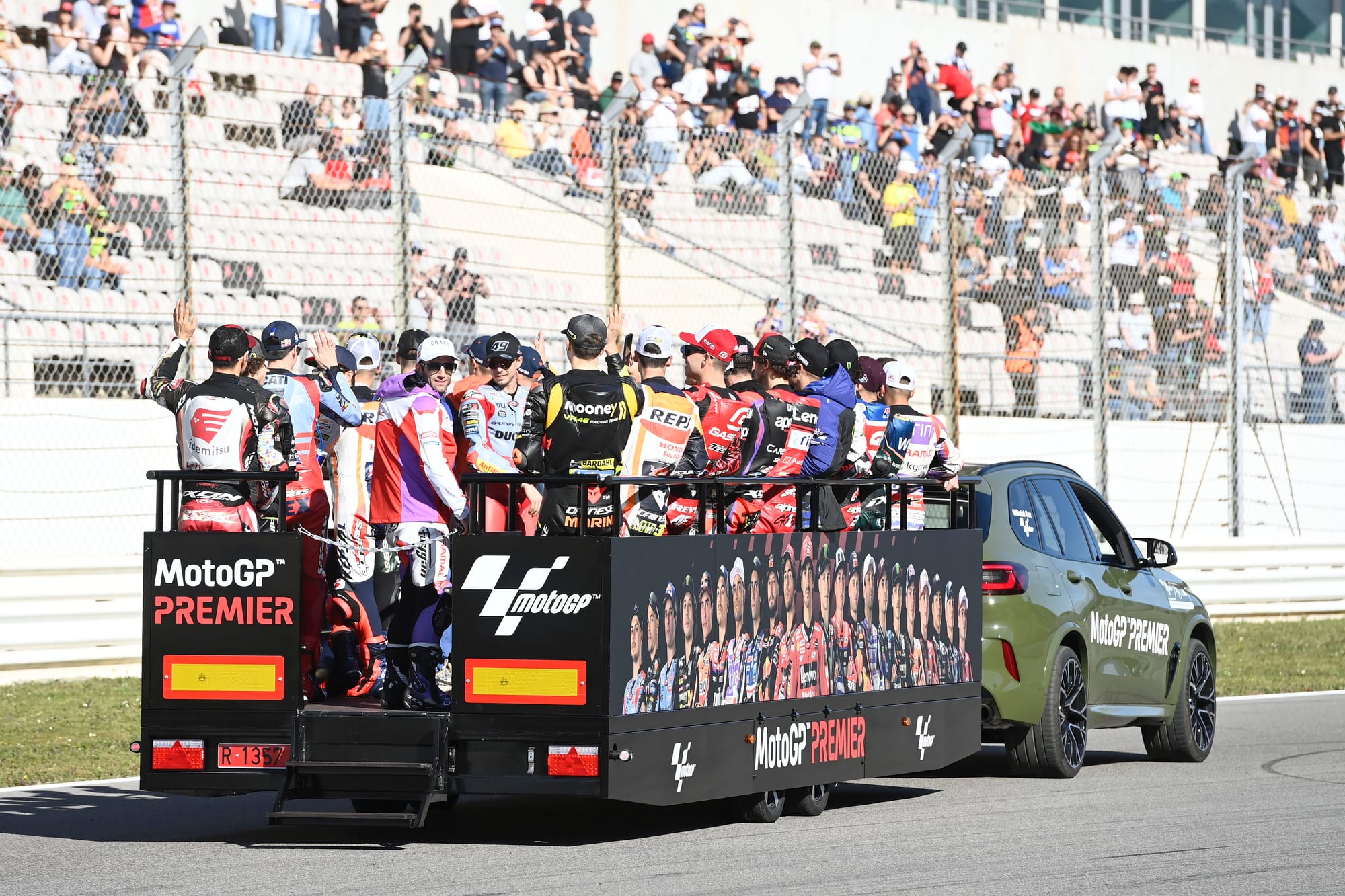
It’s a far cry from MotoGP’s often-mocked bus lap of the circuit that racers there are forced through every Sunday morning before the action gets under way - and provides a model that not only allows fans to see riders but lets them put their own spin on it as they choose their own backing music, style and creativity into selling themselves.
It's also in stark contrast to MotoGP only focusing on a small handful of superstars. See both the retirement of Valentino Rossi and the long-term absence of Marc Marquez due to injury, without a clear successor to the pair, for examples of how it's already been hurt by that.
There’s a reason that every champion since Marquez (and we’ve had three different ones in four years) is yet to make anything near the same impact on the casual fanbase. More controlled media exposure and social media use plus less time in the spotlight have left their personalities unknown to fans at home.
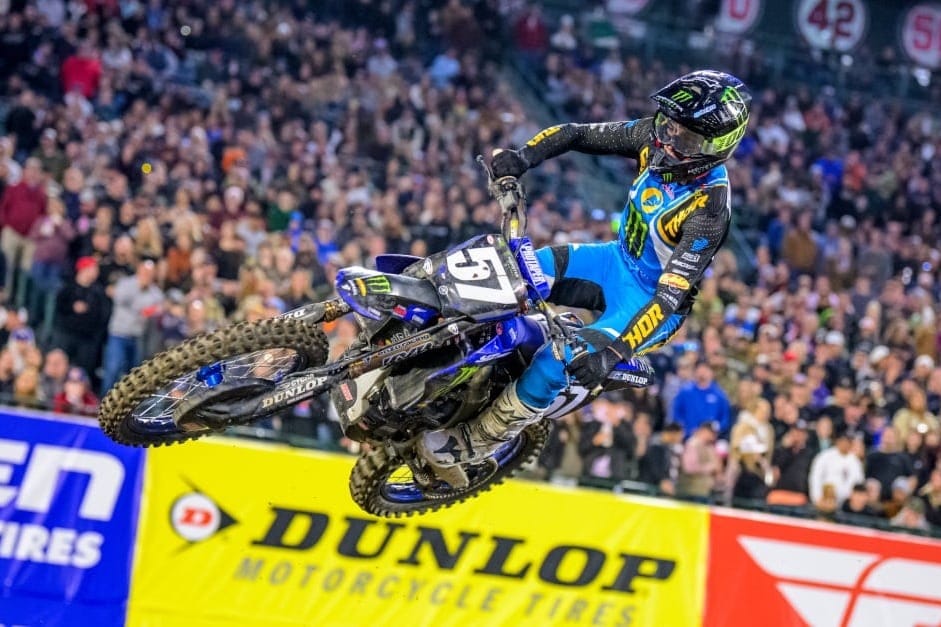
Of course, one trip to Supercross isn’t going to turn around the issues that MotoGP has right now in terms of crowds and audiences.
But at a time when the world championship should be looking closely at what its two-wheeled rivals are doing, there are certainly lessons to be learned from the off-road series.

